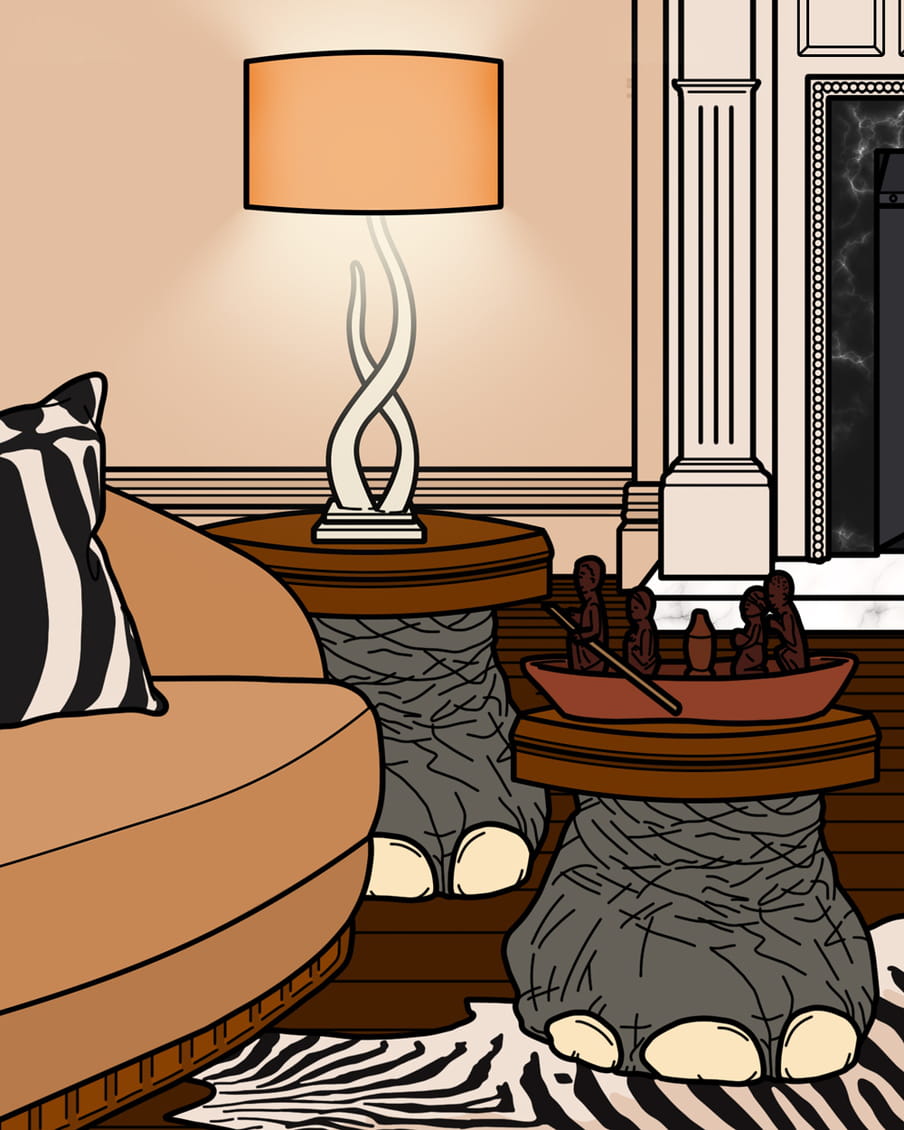On a Friday afternoon in early October, I stood in a beer garden in one of England’s eastern counties and peered into a smallish plastic container that held the upper part of a human skull.
As a gentle rain and autumn leaves of auburn, brown and yellow fell to the ground, what is thought to be the century-old skull of Mlozi bin Kazbadema was placed on a wooden table for me to examine.
I could see traces of soil and a mark that could have been an abrasion consistent with the head wound Mlozi is recorded as having received before he was executed by British forces on 4 December 1895.
According to accounts I have been able to find – most based on British colonial sources – Mlozi had been a powerful and divisive Swahili-Arab figure within east Africa’s slavery economy and its adjacent ivory trade.
British commercial and missionary interests allied closely in seeking to monopolise the ivory trade in the region and control of land and religious beliefs of the local population during the last decades of the 19th century. Mlozi traded with the Glasgow-based African Lakes Corporation for many years before he and his forces latterly resisted the company but were eventually defeated by the British Central Africa administration in 1895.
Captured with a severe head wound, he was then tried and executed by hanging at Mpata, Nyasaland. Afterwards Mlozi was beheaded, his body hung by the ankles for several days, and his skull taken to Scotland as a trophy by mercenary Walter Gordon Cumming. Cumming also took the skull of one of Mlozi’s fighters whom he’d killed in the battle, intending to use both remains as bookends.
Laid out for view in a quintessential English village, this skull – an artefact of the brutality of colonisation – seemed extremely ordinary. The intended ornamental use of Mlozi’s head exemplifies how the extreme violence of European colonial conquest has routinely sat alongside its cultural and scientific achievements as symbols of refinement and status. Indeed, it is through colonialism that a great many European homes have been built and then adorned.

‘The detritus of empire’
The practice of taking human remains as trophies was common within European military history during the 19th century, according to Danish historian Kim A. Wagner, whose research focuses on “forms and functions of violence and cultural (mis-)understanding … between the western and the non-western worlds”.
“Trophy-taking is often associated with irrational behaviour and rogue soldiers taking matters into their own hands [but] in the 19th century it was far more common than we usually think,” says Wagner.
‘Head-hunting is one of the most emblematic practices associated with savages. And yet when we look at it historically, it’s the white man who is the head-hunter’
“In the mid-19th century indigenous people are quite often not recognised as fully human, but rather seen as part of the natural flora. So if you collect specimens of exotic flowers, animals, birds, monkeys that you stuff and send home […] in much the same vein you would also send home a skull of a local. That was fully acceptable, socially acceptable and even a respectable practice."
Wagner adds: "Head-hunting is one of the most emblematic practices associated with savages. And yet when we look at it historically, it’s the white man who is the head-hunter.”
And “the white man” sent home much more than heads.
Around 25,000 colonial officials returned to Britain during the mid-20th century alone as formal colonial rule came to an end. Many others who had lived and worked in British colonies outside of any government role came back too, and they brought all kinds of stuff with them.
Seeking out what others have called “the detritus of empire”, historians Chris Jeppesen and Sarah Longair discovered an assortment of wooden carvings, paintings, drums and other musical instruments, furniture, and a set of arrows used as a hat-rack. In one home, a wash-basin had been kept intact along with “a roll of incredibly abrasive looking 1950s toilet paper”.
Some items were proudly displayed. Others had been stored away from view in attics and cupboards. There were lion and leopard skins, many ivory ornaments, and elephant feet used as wastepaper bins. There was a machete shattered by a bullet, taken from the body of a slain Land and Freedom Army (“Mau Mau”) fighter in Kenya in the 1950s. Some interviewees had devoted “Africa rooms” in their homes, or other ways of consciously using the techniques of museum curation and display, such as labelling and glass cabinets.
As western countries grapple with their colonial histories – how to discuss them and how these legacies endure today – these material objects found in homes, and not museums, provide an important, though often neglected, starting point.
Memories of empire
The homes of European families have long gone unexamined as sites for the construction of colonial and post-colonial memory. But in recent years, a small group of young historians have turned their attention towards these intimate spaces.
The scholars themselves make no such judgment, but their work does provide a way to understand why colonial families and their descendants, who presumably have no appetite for the practice today, hold on to these objects that ostensibly represent a period defined by violence, subjugation and exploitation.
Jeppesen and Longair interviewed more than 30 elderly former colonial officials in their own homes across the United Kingdom and found that the world of their youth – often memorialised through domestic ornaments and furniture – was frequently fondly remembered as a time and place of family and friendship, of personal ambition and adventure, of love, hope, pleasure, desire, and loss.
I also spoke with several elderly people now living in England, who had spent their early years in colonised countries in Africa and brought souvenirs “home”. These conversations offered a way of understanding how the colonial period is perceived in domestic settings, as well as a glimpse at the anxieties attached to the passage of such heirlooms between generations, as the meaning they once had becomes increasingly tenuous.
One gentleman who agreed to talk with me was born in Nyasaland in 1939, and has kept a range of tables, stools and other furniture that carry memories of Malawi and especially of his father, who was a colonial administrator, working on agriculture and natural resources.
“I’m hoping it’ll stay in the family when I go,” the 80 year old told me. “I’ve requested in my will that it do so. We have fond memories of that time.”

How a man’s skull ends up on display
These domestic objects, and the attachment to them, make clear the distinction between public and private memory – though these two modes of knowledge and feeling about the past are in constant interplay, each informing and responsive to the other.
German historian Britta Schilling defines public memory as being “primed through interactions in the public space, media and institutions”, whereas private memory is “usually transmitted orally” and often “within the family, it forms a unique ‘archive’ of stories and anecdotes on the one hand but also material relics on the other”.
Cherished notions of white European innocence and benevolence are sustained through a focus on simple curiosity
It is apparent from what has been written by these historians that for the families who inherit these colonial relics, these items are simply a part of their memories. There is little possibility of extricating the personal experience from the political context.
In Schilling’s research members of the “postcolonial generation” of some of the most notorious German colonial officials – typically their grandchildren – remembered their ancestors as “harmlessly quirky characters”.
“Claus von Wissmann told me how his relative crossed the Congo Basin on behalf of Leopold II riding a tamed ox,” writes Schilling. “Herman von Wissmann, who eventually became governor of German East Africa [now Tanzania], however, may also be remembered for his self-proclaimed acts of violence against ‘natives’.”
“Olof von Lindequist said his ancestor is most often talked about in his family in regard to his introduction of karakuls (Persian lambs) into [German] Southwest Africa [now Namibia]. Although his time as governor of German Southwest Africa is also mentioned in the family archive, Friedrich von Lindequist’s internment of Herero in Southwest Africa following the German-Herero war are not elaborated upon.”
Schilling gives other examples: “Ewald and Nikolaus von Puttkamer showed me a photograph of the vast mansion that their relative Jesko von Puttkamer had built in the middle of the jungle during his reign as governor of Kamerun [now Cameroon]. Despite, or perhaps because of, Puttkamer’s intense commitment to building his home there, the German government recalled him in 1907, accusing him of excessive spending and ‘severity to natives’ during a period of heightened indigenous resistance to colonial rule.”
Germany is by no means alone in fixating on colonial leaders’ eccentricities and hobbies at the expense of more troubling political histories. On a recent visit to Winston Churchill’s home, Chartwell, now a popular museum, I noticed that there was no mention of Churchill’s role in, for example, contributing to the causes of the Bengal Famine of 1943 (death toll: approximately three million). Visitors were instead encouraged to learn in detail about Churchill’s great fondness for butterflies.
You can trace a thread from these personal memories to the public framing of colonists as wide-eyed adventurers who just happened to possess enormous political power over non-European people. Cherished notions of white European innocence and benevolence are sustained through a focus on simple curiosity. Even the most basic of historical facts manage to slip through the cracks in colonial families and the nations to which they belong. It is in this way that a man’s skull can be taken and displayed in a museum or used to hold novels in place on a shelf.
Repatriation doesn’t mean absolution
In 2017, French president Emmanuel Macron announced that the skulls of 37 anticolonial fighters from the 19th century would be returned to Algeria. They had been kept in the Musée de l’Homme in Paris. Seven years before, the French parliament had voted to return a large number of mummified Māori heads to New Zealand from various museum collections across the country.
Western discussions of history often suggest that repatriation provides absolution. That by returning things – and bodies – taken through colonisation, what was lost can be restored
There are thought to be hundreds of skulls of victims of the Herero genocide in collections in Germany, where they were taken for study by racial anthropologists in the early years of the 20th century. Some of these were only returned to Namibia in 2018.
Major treasures, as well as the remains of anticolonial martyrs, in grand national museums have come to be the focus of much anxiety about ongoing colonial legacies and what to do about them. They are now the best-known venues through which histories of colonialism and the possibility of redress is debated within the public discourse of old European powers today.
This debate often suggests that repatriation provides absolution. That by returning things – and bodies – taken through colonisation, what was lost can be restored; accounts can be settled.
For example, Geoffrey Robertson QC called on the British Museum to “wash its hands of the blood” by returning its “loot”, citing the well-known artefacts taken from Greece, Easter Island and Nigeria, and kept in the museum.
In his new book Who Owns History?: Elgin’s Loot and the Case for Returning Plundered Treasure, Robertson, a prominent British human rights lawyer, writes: “We cannot right historical wrongs, but we can no longer, without shame, profit from them.”
Robertson isn’t wrong, but as Mlozi’s story illustrates, it isn’t always possible to simply put back what was taken.
According to its custodian, Mlozi’s descendants have been uncontactable, and the government of Malawi has shown little interest in seeking the repatriation of Mlozi’s remains.
I contacted Mwayi Lusaka, principal ethnographer in the cultural history department of Malawi’s Department of Museums and Monuments, who says a “convincing argument” for the return of Mlozi’s skull would need to be made to a sceptical Malawian public, who may pose questions such as: “Why should Malawi repatriate a figure who terrorised and haunted local communities through slavery? In a postcolonial context, was Mlozi a Malawian, a Zanzibari, or Tanganyikani?"

So, what do we do with colonial legacies?
Astonishing ignorances can be produced and sustained by the stories that families tell themselves about the “exotic” objects within their family collections. But these need not be permanent. Colonial memories can be addressed, and even remedied, depending on the response of successive generations.
A notable example comes from what Schilling calls the “extra-colonial” generation – younger men and women who are re-encountering stories of colonialism following the widespread forgetting that has taken place in Germany in the past 50 years.
Laetitia von Trotha, born in 1976, learned nothing about German colonialism at school, nor from her family. According to Schilling, she first came to know of her notorious ancestor Lothar von Trotha through a friend at university who lent her books and parts of a film about Herero Day, the annual commemoration of the German-Herero War in Namibia.
A proper reckoning with colonialism through the private sphere is urgent and necessary
This prompted von Trotha to screen the film for her extended family at their gathering in 2001. They, in turn, resolved to engage in a process of reconciliation, meeting with the supreme chief of the Herero people, fundraising for charitable causes in Namibia, and visiting the country, where they made the following statement: “We, members of the Trotha family, are ashamed of the horrible events that took place here one hundred years ago. We deeply regret what happened to your people, but also to the Nama and the Damara: the gruesome and unjustified death of thousands of men, women and children.”
Objects are an essential component in memory-making. The stories that surround them show just how deeply enmeshed personal and sentimental memories are with recollections of larger political and economic structures.
The nostalgia for colonialism that continues to distort national political narratives and identities in many European countries is most obviously rooted in the desire to return to a formalised mode of exploitation and expropriation that set white European men at the top of an economic hierarchy from which they were the primary beneficiaries. But the themes that drive the lived experience of such nostalgia are not straightforward.
This is one reason why documentation and discussion of the crimes and violations of colonialism can feel like a personal attack. The stubborn attachment to empire that plays out at the national level has personal, intimate roots.
So what do we do with these colonial objects? Where the associations are intimate, their meaning bound up with personal histories, and many of the items themselves are at risk of becoming merely household clutter, these are difficult conversations to have.
Part of the reason why the museum, rather than the home, has been a focus for post-colonial reckoning is the museum’s institutional nature. Here, questions of identity ("what do our actions from the past say about who we are today?"), of plunder and historical violations can be broached without needing to attribute these actions to individuals.
A proper reckoning with colonialism through the private sphere is urgent and necessary. It also feels like an increasingly remote possibility. It is easier to trace the lineage of colonialism’s leading architects and to expect the sort of acknowledgment the von Trotha family demonstrated.
But western colonial expansion at its peak involved hundreds of thousands of people. At its violent end, the vast majority returned to their countries of origin – and to other parts of the world – taking with them mementos and memories. With each new generation, how can this family memory be held up for public scrutiny?
Similarly, the idea of repatriating these objects – no matter how inappropriate the display of them seems – can seem absurd. Who do you send lion skins to, or even skulls that come with no notes to indicate who the person may have been?
What can be expected is that those who inherit the material legacies of colonialism should know the true and often gruesome history of those objects, not just the quaint sanitised stories of intrepid relatives with a love for nature. In the west, colonial history today is part of who we are. As the expression goes: it is part of the furniture.
Dig deeper
 What do we do with our colonial relics?
Consider the pith helmet, a symbol of exploration and expansion – and a fashion accessory worn by Melania Trump. Does it still carry meaning or is it old hat?
What do we do with our colonial relics?
Consider the pith helmet, a symbol of exploration and expansion – and a fashion accessory worn by Melania Trump. Does it still carry meaning or is it old hat?


